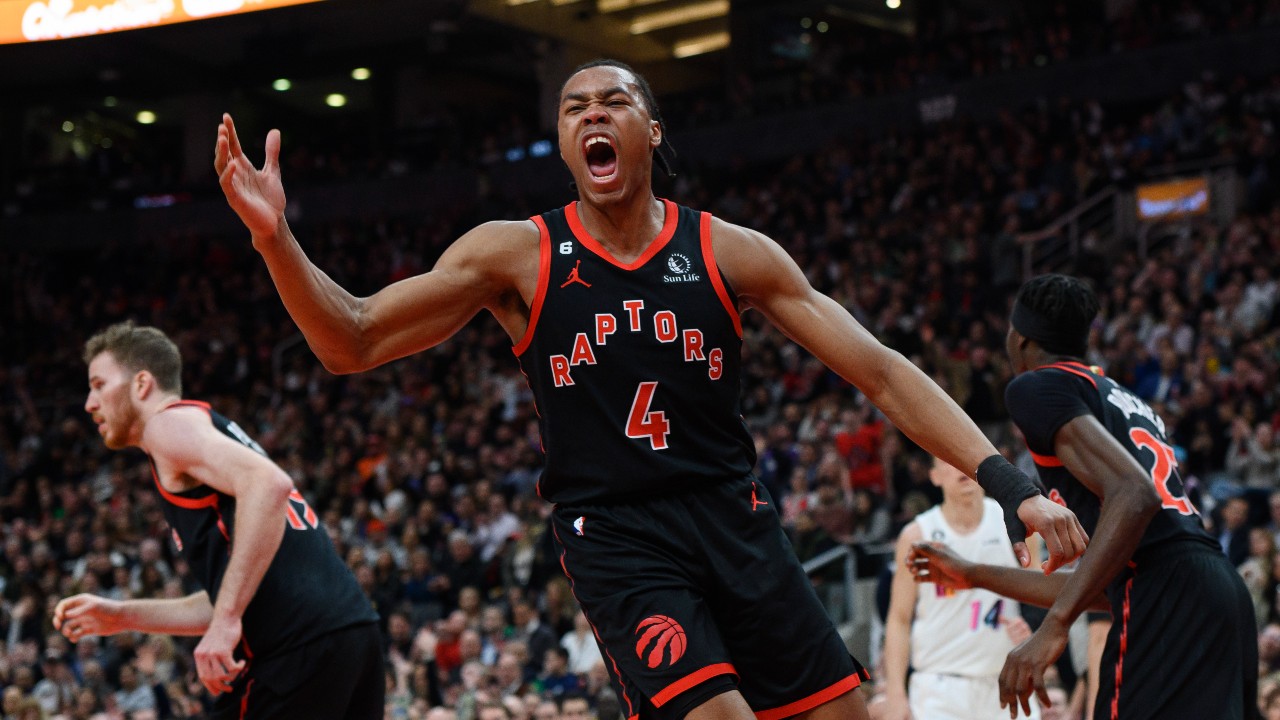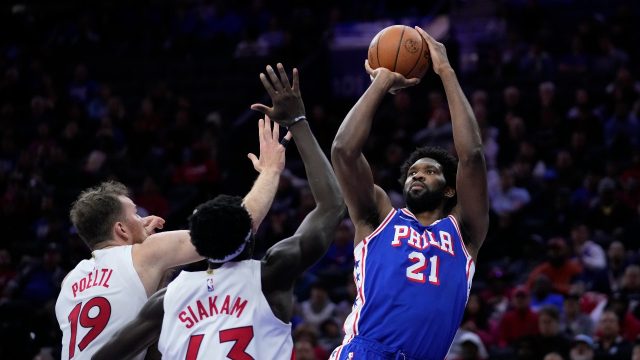
TORONTO — The NBA schedule-makers did data-oriented Toronto Raptors fans a favour early on, stacking six games in the first nine days of the season.
The Raptors went 2-4 in those games and probably should be 3-3, despite a tough stretch of opponents. Although that .500-ish performance level should be familiar, how they’ve gotten there has been extreme — the Raptors have been the best team in the league limiting opponents’ effective field-goal percentage and have the worst halfcourt offence in the league. I hope you enjoyed late-90s basketball.
It’s still quite early to draw conclusions. Team-level stats don’t begin to stabilize until around the 20-game mark, and though we can learn important things early at the individual level, some progressions or regressions need a large sample to make conclusions.
This early, you’re looking for three things: How extreme is the change, how well does it line up with the priors and if there’s a good underlying explanation for the change.
With that in mind, today we’ll look at five stat trends on the offensive side that I’m keeping an eye on over the next couple of weeks. If they continue, we’ll dive deeper into their root causes and takeaways. Early next week, we’ll look at the defensive side.
1. The halfcourt offence is historically bad
The Raptors have scored 81.4 points per-100 halfcourt possessions. What that means is that if the Raptors don’t get out in transition, and the play evolves in a set-up, halfcourt setting, they’re averaging about 0.81 points each time.
That is unspeakably bad. It is dead last in the league and 12.5 points per-100 possessions worse than the league average. They’ve had only one game, against Milwaukee, where they were even a league-average halfcourt offence, and that was just barely.
Last season, the Raptors scored 94.5 points per-100 possessions in the halfcourt, which ranked 25th, ahead of only the Magic and the four tanking teams (league average was 98.4). A glaring weakness has gotten worse early on.
This trend satisfies all three of our criteria for concern. First, it’s extreme. Like, Jim Ross yelling about Jeff Hardy in a TLC match extreme. That doesn’t mean we expect it to continue to an extreme degree, but your single-game performances will usually fall within a certain distribution of who you are, and having five outlier-bad games to start the season suggests the Raptors’ true talent level is on the below-average end of things.
Second, this lines up with the priors. While nobody would have guessed things would be this shaky to start, everyone should have anticipated this was the team’s biggest challenge. The Raptors are built to defend at an elite level, exhaust teams in the running game and merely survive in the halfcourt. Again, we didn’t expect it this extreme, but the fact that we expected them to struggle scoring suggests this isn’t all noise.
Finally, there’s a reasonable explanation for this. The Raptors were bad last season and a lot of the pieces, including three-and-a-half starters and two top bench players, were here. There is a lack of shooting talent. And most importantly, new head coach Darko Rajakovic is installing new offensive principles that represent a pretty dramatic shift from prior years; it’s entirely reasonable to think it would take the Raptors more time to find their footing offensively than defensively. Which takes us to …
2. The system changes are clear, they’re just not leading to results yet
To simplify Rajakovic’s approach, the Raptors want to play point-five basketball. That is, when a player gets the ball, ideally they decide within 0.5 seconds whether to shoot, pass or drive. The result is free-flowing motion with on- and off-ball activity, a lot of passing, and small advantages cascaded into larger ones.
When it works, it’s beautiful. When it doesn’t, it can result in a lot of turnovers and a lot of passing that looks like passing for the sake of passing.
The Raptors lead the league in passing, making 316 passes a game, up from 292 last year, when they ranked eighth. That current number would have been second to the Warriors last season, but the Warriors created 55.8 potential assists (shots that came directly after a pass) and 78.9 assist points (points that were assisted on), whereas the Raptors sit at 52.2 (fourth) and 67 (13th), respectively. The Raptors also have the second-lowest time-per-touch and the third-fewest dribbles per touch.
In short, they are moving the ball more quickly and more often than just about anyone. That’s a real positive, and it shows that the Raptors players are buying into Rajakovic’s system and trying to execute it, for the most part.
However, another way you lead the league in passes is by having long possessions where you have to pass a lot because a shot doesn’t materialize, and the Raptors take more late-shot-clock attempts than anyone except the Knicks and Nuggets. Even as one of the league’s best transition teams, the average Raptors possession takes 14.1 seconds, a bottom-10 mark in the league.
Again, this isn’t unexpected. A new system takes time, and this particular system requires players to learn each others tendencies and far more on- and off-ball actions than they’re used to.
A telling example that drives that home: The Raptors are cutting way more than before. Based on data provided to Sportsnet, the Raptors are cutting off off-ball screens 54.8 times per 100 possessions this season, a 35-per cent increase over last season … but they’re the worst team in the league scoring off cuts.
The process is coming along. It might take a little while still for the results to come around.
3. Bench and transition units have really struggled
Toronto’s starters have played 71 minutes together, sixth-most of any lineup in the league. In those minutes together, they have a plus-19.9 net rating and have scored at an acceptable rate, with a 117.1 offensive rating and a 58th-percentile performance with their halfcourt offence. The offensive execution could still be better, but the defence and transition game are there, as are the results.
So, about every other lineup. It is … not great.
There are some exceptions, particularly in units where Gary Trent Jr. joins a lineup with three or four starters. This is why Trent is usually the first sub in, allowing Scottie Barnes to take an early break and return to anchor bench units later. Trent and Gradey Dick with three starters has had success offensively in small minutes and makes a lot of sense as a key transitional lineup on paper, so we should see more of that.
Everything else has been tough. When the Raptors have one or more of their five starters off the floor, they have a net rating of -8.6. In an average game, the Raptors have won the starters minutes but lost the bench minutes by a wider margin. That’s not great!
Malachi Flynn has received most of the ire for these bench units, and that’s fair to an extent. The Raptors have been outscored by a whopping 49 points in his 78 minutes, and despite some good defensive moments the last two games, he’s been a turnover machine. More importantly, though, the bench is often asked to play with four bench players at once, and the pieces don’t really fit. The Raptors have been outscored by 36 points in just 39 minutes of Barnes-and-bench or Pascal Siakam-and-bench units.
The Raptors had hoped their depth was stronger this season. Individually, it might be. At some point, they’ll have to explore different combinations or use more two-starter lineups, unless these are growing pains they’re willing to live with. (I’d argue that’s fair as far as Barnes anchoring bench units, but you’d still want better-fitting pieces supporting that.)
4. The transition offence is still quite good despite fewer turnovers to run off
Let’s get some positivity in here. The Raptors are the second-best transition team in the league, trailing only Indiana. They’re lethal off live-ball turnovers and really solid running off live defensive rebounds.
Obviously, they have the personnel and the mentality to thrive here. The question was whether a more conservative defence in terms of forcing turnovers would allow them to run as much. They’ve gone from first in opponent turnover rate to 20th and are the league’s second-worst defensive rebounding team. That should hurt their transition opportunities, but instead they’ve just run when they can with even more conviction — their 22.2 fast-break points per-game would be the most in the league since 2016-17 if it sustained.
This feels very real. Even if their transition effectiveness decreases a bit, they should be better on their own glass, giving them more chances to run. It’s an extreme performance, it aligns with the priors, and it has a sound explanation.
5. Scottie Barnes can shoot the three now
I was tempted to swing back negative here with something on Siakam’s struggles, but, a) they’re so all over the place, it’s hard to get a cohesive analysis beyond him (or them) just not finding his place in the new system yet, and b) my goodness, Barnes has been incredible to start the season.
The raw numbers jump out, of course: 21.3 points, 9.7 rebounds, 5.8 assists and two blocks per game and massive spikes in both usage rate and efficiency, jumps that don’t usually happen together. Carrying a larger load is more difficult; you’re not supposed to also get exponentially more lethal as you expand your role. Barnes has been awesome, and his overall growth deserves its own piece.
For now, I want to note that he’s 11-of-28 on 3-point attempts. That’s 39.3 percent, well above the 30.1 and 28.1 percent he shot in his first two years. Now, 28 attempts is beyond a tiny sample; 3-point shooting talent doesn’t stabilize until around 700 attempts, so we’re looking for enough information to say he’s improved, not that he’s suddenly Kawhi Leonard as far as multi-faceted forward scoring hubs.
Although it’s a small sample of attempts, there’s some other information that suggests at least some shooting growth is real here. Barnes has always shown really good touch around the basket, and on things like hook shots and, more recently, free throws. He’s also shooting 80 per cent on a small sample of long twos, which utilize similar skills to his threes. Mechanically, Rajakovic said earlier this season that he was really encouraged about Barnes’ potential growth.
And it would be one thing if all of Barnes’ makes were catch-and-shoot corner looks, but none are. He’s 0-for-3 in the corners and 11-of-25 on above-the-break threes, including 3-of-6 on pull-ups. Above-the-break shots, especially self-created ones, are more difficult; that Barnes is succeeding on a tougher diet of attempts is even more encouraging. There just aren’t many guys his size comfortable executing a step-back transition three after feigning a drive to the rim.
It will take a sustained stretch of shooting for defences to respect this. Barnes is so effective driving and bullying in the paint that teams will dare him to shoot over top of screens to prevent the drive. As Rajakovic said, if teams start closing out hard to Barnes, “god help you” defending the subsequent drive.







